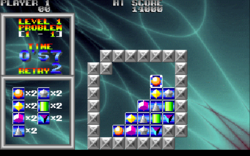This article needs additional citations for verification .(January 2017) |
| Brix | |
|---|---|
 | |
| Developer(s) | Epic MegaGames |
| Publisher(s) | MicroLeague Interactive Software |
| Designer(s) | Michael Riedel |
| Composer(s) | Dan Froelich |
| Platform(s) | MS-DOS |
| Release | 1991 (original) December 1992 (Epic version) |
| Genre(s) | Puzzle |
| Mode(s) | Single-player |
Brix is a puzzle video game for MS-DOS, developed by Michael Riedel and produced and published in 1991. An updated version with enhanced graphics and sound was published by Epic MegaGames in 1992. It is a clone of Taito's Puzznic , and thus bears strong graphical and some gameplay similarities to Plotting , also produced by Taito. [1] An enhanced version, Brix 2 Deluxe, was released alongside the Epic MegaGames release, with dozens of new levels and a level editor. [2]
